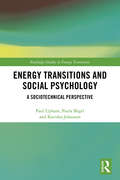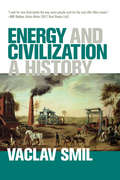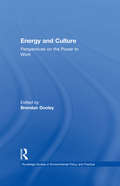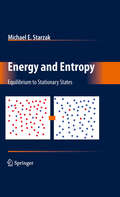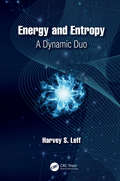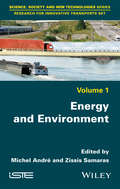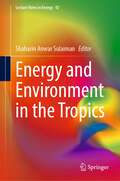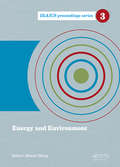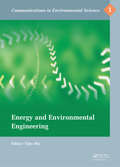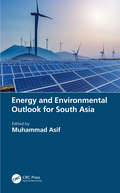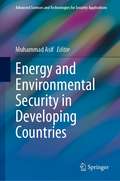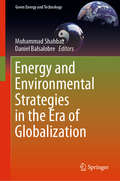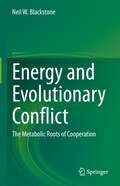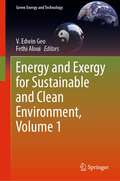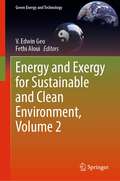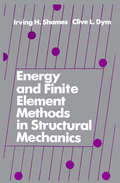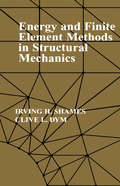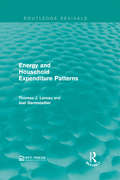- Table View
- List View
Energy Transitions and Social Psychology: A Sociotechnical Perspective (Routledge Studies in Energy Transitions)
by Paul Upham Paula Bögel Katinka JohansenThis book explains how social psychological concepts can be closely integrated with sociotechnical perspectives of energy transitions. It shows the value of actor-centred analysis that acknowledges the role of individual-level processes within their wider contexts of energy supply and use. In this way, the book connects social psychological and sociological frames of analysis, preserving the value of both, to provide multi-level, analytically extended accounts of energy transitions processes. Sociotechnical thinking is about the interactions of people and technology, including the rules, regulations and institutions involved. Such perspectives help to identify the many forms of path dependency that can make change difficult. Human behaviour plays a strong role in maintaining these path dependencies, but it can also introduce change. This book advocates a deliberately interdisciplinary research agenda that recognises the value of social psychological perspectives when seeking to create new pathways for energy supply and use. At the same time, it also demonstrates the value of sociotechnical perspectives for energy-related social psychology. Energy Transitions and Social Psychology will be of great interest to students and scholars of energy transitions, environmental and energy psychology, sustainable development and innovation studies, as well as students and scholars of environment and energy more generally.
Energy Transmission and Synchronization in Complex Networks
by Nicolás RubidoThis work tackles the problems of understanding how energy is transmitted and distributed in power-grids as well as in determining how robust this transmission and distribution is when modifications to the grid or power occur. The most important outcome is the derivation of explicit relationships between the structure of the grid, the optimal transmission and distribution of energy, and the grid's collective behavior (namely, the synchronous generation of power). These relationships are extremely relevant for the design of resilient power-grid models. To allow the reader to apply these results to other complex systems, the thesis includes a review of relevant aspects of network theory, spectral theory, and novel analytical calculations to predict the existence and stability of periodic collective behavior in complex networks of phase oscillators, which constitute a paradigmatic model for many complex systems.
Energy Works
by Janette SchusterNIMAC-sourced textbook <p><p> Energy Works allows students to explore different kinds of energy and see how energy is converted to different forms.
Energy Works: Below-Grade Reader (Building Blocks of Science Literacy Series)
by Janette SchusterLexile range: 520L–670L. Energy Works Below-Grade Reader encourages students to consider energy in all its different forms. Topics include: Energy and Its Forms; Energy Sources; the Science and Engineering Practices of analyzing data; and a look into the daily life of an electrical engineer.
Energy and Civilization: A History (The\mit Press Ser.)
by Vaclav SmilA comprehensive account of how energy has shaped society throughout history, from pre-agricultural foraging societies through today's fossil fuel–driven civilization."I wait for new Smil books the way some people wait for the next 'Star Wars' movie. In his latest book, Energy and Civilization: A History, he goes deep and broad to explain how innovations in humans' ability to turn energy into heat, light, and motion have been a driving force behind our cultural and economic progress over the past 10,000 years.—Bill Gates, Gates Notes, Best Books of the YearEnergy is the only universal currency; it is necessary for getting anything done. The conversion of energy on Earth ranges from terra-forming forces of plate tectonics to cumulative erosive effects of raindrops. Life on Earth depends on the photosynthetic conversion of solar energy into plant biomass. Humans have come to rely on many more energy flows—ranging from fossil fuels to photovoltaic generation of electricity—for their civilized existence. In this monumental history, Vaclav Smil provides a comprehensive account of how energy has shaped society, from pre-agricultural foraging societies through today's fossil fuel–driven civilization. Humans are the only species that can systematically harness energies outside their bodies, using the power of their intellect and an enormous variety of artifacts—from the simplest tools to internal combustion engines and nuclear reactors. The epochal transition to fossil fuels affected everything: agriculture, industry, transportation, weapons, communication, economics, urbanization, quality of life, politics, and the environment. Smil describes humanity's energy eras in panoramic and interdisciplinary fashion, offering readers a magisterial overview. This book is an extensively updated and expanded version of Smil's Energy in World History (1994). Smil has incorporated an enormous amount of new material, reflecting the dramatic developments in energy studies over the last two decades and his own research over that time.
Energy and Conflict: The Life and Times of Edward Teller
by Stanley Blumberg Gwinn OwensHere is the first biography of Edward Teller, based on exclusive access to the man and the archives. This is the life story of perhaps the most controverisal and certainly one of the greatest nuclear physicists of the twentieth century. widely known as the father of the hydrogen bomb, Teller was a genius among giants in the scientific community, his career coterminus with the nuclear age. His controversy with Robert Oppenheimer, here updated, constitutes one of the dramatic high points of the Cold War, in which Teller has been an absolutely crucial figure.
Energy and Culture: Perspectives on the Power to Work (Routledge Studies in Environmental Policy and Practice)
by Brendan DooleyHow will humanity continue to meet its energy needs without destroying the conditions necessary to sustain human life on earth? The search for an answer to this question depends as much on the past as on the present; and as much on the physical sciences as on the social sciences. This book offers a truly trans-disciplinary and trans-cultural look at the problem of energy production and consumption in modern times. Discussing issues of history, politics, science, risk, lifestyle and representation, contributors demonstrate that experiences through time can provide insights into the kinds of solutions that have succeeded, as well as reasons why other solutions have failed. They also show what different countries and cultures might learn from each other, emphasizing how discoveries in one discipline have inspired new approaches in another discipline. Among many other important conclusions, the book suggests that energy transitions do not occur simply because of the exhaustion of old energy sources, and any solutions to the incipient energy crisis of the 21st century will depend on people's perceptions of science, environment and risk, informed and shaped in turn by the media.
Energy and Electromagnetism
by Lawrence Hall of Science University of California at BerkeleyNIMAC-sourced textbook
Energy and Entropy
by Michael E. StarzakThis book presents the various branches of thermodynamics - classical, statistical, and others - and kinetics in a lucid manner that will appeal both to advanced undergraduates and beginning graduate students. The mathematical treatment is neither overly elaborate nor absent, but has been illustrated by examples from biology, physics, and other disciplines. The models drawn from diverse areas should make it attractive to readers seeking a clearer physical understanding of these fields and how they interrelate. Features include: worked examples exercises solutions to some of the exercises, available to all readers solutions to all the exercises, available to instructors.
Energy and Entropy: A Dynamic Duo
by Harvey S. LeffEnergy is typically regarded as understandable, despite its multiple forms of storage and transfer. Entropy, however, is an enigma, in part because of the common view that it represents disorder. That view is flawed and hides entropy’s connection with energy. In fact, macroscopic matter stores internal energy, and that matter’s entropy is determined by how the energy is stored. Energy and entropy are intimately linked. Energy and Entropy: A Dynamic Duo illuminates connections between energy and entropy for students, teachers, and researchers. Conceptual understanding is emphasised where possible through examples, analogies, figures, and key points. Features: Qualitative demonstration that entropy is linked to spatial and temporal energy spreading, with equilibrium corresponding to the most equitable distribution of energy, which corresponds to maximum entropy Analysis of energy and entropy of matter and photons, with examples ranging from rubber bands, cryogenic cooling, and incandescent lamps to Hawking radiation of black holes Unique coverage of numerical entropy, the 3rd law of thermodynamics, entropic force, dimensionless entropy, free energy, and fluctuations, from Maxwell's demon to Brownian ratchets, plus attempts to violate the second law of thermodynamics
Energy and Environment
by Zissis Samaras Michel AndréTransport systems are facing an impossible dilemma: satisfy an increasing demand for mobility of people and goods, while decreasing their fossil-energy requirements and preserving the environment. Additionally, transport has an opportunity to evolve in a changing world, with new services, technologies but also new requirements (fast delivery, reliability, improved accessibility). In this book, recent research works are reported around the triptych: "transport, energy and environment", which demonstrates that vehicle technologies and fuels can still improve, but it is necessary to prepare their implementation (e.g. electro-mobility), to think of new services, and to involve all actors, particularly enterprises, who will be the drivers of innovation. Mitigation strategies are studied to promote innovative, multimodal and clean transports and services. Research progress is reported on air pollution, vibrations and noise, their mitigation and assessment methodologies.
Energy and Environment in the Tropics (Lecture Notes in Energy #92)
by Shaharin Anwar SulaimanThe tropical zones are dominated by developing countries, which mainly face problematic environmental issues. Different than four-season countries, tropical countries have a continuous summer-like season and therefore they are rich in clean energy sources like solar and biomass. Hence, the mitigations of environment and energy issues in the tropics would require specific understanding and different approach to solutions. This book offers an assortment of studies on scenarios of environment as well as energy demand and power generation technologies in the tropics. Many of the countries within the tropics are highly populated, and this results in various problems related to the environment and energy. The demand for energy in these countries keeps increasing but concurrently there are also environmental issues that require serious attention. As the global concern on the environment is alarming today, the choice of power generation should be of the cleanest possible resource. This various reports on research activities carried out in the tropics on the aspect of environment and energy presented in this book are highly beneficial for those who like to see an improvement in the tropics with regard to environment and energy systems.
Energy and Environment: Proceedings of the 2014 International Conference on Energy and Environment (ICEE 2014), June 26-27, Beijing, China (IRAICS Proceedings)
by Dawei ZhengThe 2014 International Conference on Energy and Environment (ICEE 2014) was held June 26-27 in Beijing, China. The objective of ICEE 2014 was to provide a platform for researchers, engineers, academics as well as industry professionals from all over the world to present their research results and development activities in Energy and Environment res
Energy and Environmental Engineering: Proceedings of the 2014 International Conference on Energy and Environmental Engineering (ICEEE 2014), September 21-22, 2014, Hong Kong (Communications in Environmental Science)
by Yijin WuThe 2014 International Conference on Energy and Environmental Engineering (ICEEE 2014) was held September 21-22, 2014 in Hong Kong. This proceedings volume assembles papers from various professionals, leading researchers, engineers, scientists and students and presents innovative ideas and research results focused on Energy and Environmental Engine
Energy and Environmental Outlook for South Asia
by Asif MuhammadSouth Asia constitutes a key geography in the world today considering its large population and related daunting energy and environmental challenges. Many countries in the region are faced with a growing gap between energy demand and local resources, resulting in an increased dependence on imports. According to the International Energy Agency (IEA), the energy demand in South Asia will grow at a rate more than double that of the world average in the coming decades. This book addresses the critical subject of energy and environmental outlook for South Asia and presents the wider challenges and the responses at the national and regional level. Features: Discusses and addresses the ongoing energy and environmental challenges faced by almost a quarter of the global population Includes dedicated chapters for each country and presents analysis and recommendations by regional experts Examines how deteriorating air quality and persistent natural disasters are severe environmental challenges for the region Discusses the implications of global warming and climate change for South Asia Includes practical case studies throughout Energy and Environmental Outlook for South Asia will benefit a wide range of stakeholders from various fields including but not limited to energy, environment, economics, national security, and sustainable development. It also serves as a valuable resource for academics, researchers, analysts, policymakers, and representatives of utilities, industry, professional bodies, financial institutions, think tanks, and developmental organizations to better plan their initiatives, activities, and policies. It will help countries in the region and also those around the world by learning from shared experience, and ideally by collaborating for energy and environmental prosperity.
Energy and Environmental Security in Developing Countries (Advanced Sciences and Technologies for Security Applications)
by Muhammad AsifThis book presents a comprehensive account of the energy and environmental security perspectives of the developing countries. To address the subject comprehensively, it covers four geographically diverse clusters of developing countries from across the world. The regions particularly focused on are: South Asia, South East Asia, Sub Sahara Africa, and Latin America. It is a valuable contribution to the debate, and policy and research activities around the subjects of energy and environmental security in the developing countries and beyond.The book covers the interwoven subjects of energy security and environmental security in the context of developing countries for the first time. It discusses the latest dimensions, challenges, and solutions around taking into account technical, economic, social, and policy perspectives. It incorporates up-to-date data, case studies, and comparative assessment.This edited book has contributions from established as well as emerging scholars from around the world. It benefits a wide range of stakeholders from the fields of energy, environment, and sustainable development. It is of help to academics, researchers, and analysts in these fields besides having appeal for policymakers, and national and international developmental organizations. It also helps developing countries to learn from each other’s experiences.
Energy and Environmental Strategies in the Era of Globalization (Green Energy and Technology)
by Muhammad Shahbaz Daniel BalsalobreThis book provides readers with cutting-edge techniques that can be applied to energy and environmental economics. Further, it highlights the effects that both globalization and economic growth have on the environment. In addition to offering a broader perspective on the relationship between environmental pollution, energy consumption and economic growth, the book studies the relationship between economic growth and environmental damage by drawing on the theoretical hypothesis of the Environmental Kuznets Curve. The book presents new econometric techniques and innovative approaches to the study of the energy economy. Accordingly, it can be used to help analyse the current state of the energy economy, the environment and globalization, and can serve as a theoretical reference manual for doctoral students and academics seeking new analytical techniques.
Energy and Evolutionary Conflict: The Metabolic Roots of Cooperation
by Neil W. BlackstoneIn the mid- to late-twentieth century, large scientific conflicts flared in two seemingly distinct fields of scientific inquiry. In bioenergetics, which examines how organisms obtain and utilize energy, the chemiosmotic hypothesis of Mitchell suggested a novel mechanism for energy conversion. In evolutionary biology, meanwhile, Wynne Edwards strongly articulated the view that organisms may act for the “good of the group.” This work crystalized a long history of imprecise thinking about the evolution of cooperation. While both controversies have received ample attention, no one has ever suggested that one might inform the other, i.e., that energy metabolism in general and chemiosmosis in particular might be relevant to the evolution of cooperation. The central idea is nevertheless remarkably simple. Chemiosmosis rapidly converts energy, and once storage capacity is exceeded, an overabundance of product has various negative consequences. While to some extent chemiosmotic processes can be modulated, under certain circumstances it is also possible to simply disperse the products into the environment.This book argues that these two heretofore distinct scientific disciplines are connected, thereby suggesting that a ubiquitous process of energy conversion may underlie the evolution of cooperation and link major transitions in the history of life that have been regarded as mechanistically unrelated.
Energy and Exergy for Sustainable and Clean Environment, Volume 1 (Green Energy and Technology)
by Fethi Aloui V. Edwin GeoThis multi-disciplinary book presents the most recent advances in exergy, energy, and environmental issues. Volume 1 focuses on fundamentals in the field and covers current problems, future needs, and prospects in the area of energy and environment from researchers worldwide. Based on some selected lectures from the Eleventh International Exergy, Energy and Environmental Symposium (IEEES-11) and complemented by further invited contributions, this comprehensive set of contributions promote the exchange of new ideas and techniques in energy conversion and conservation in order to exchange best practices in "energetic efficiency." Included are fundamental and historical coverage of the green transportation and sustainable mobility sectors, especially regarding the development of sustainable technologies for thermal comforts and green transportation vehicles. Furthermore, contributions on renewable and sustainable energy sources, strategies for energy production, and the carbon-free society constitute an important part of this book.
Energy and Exergy for Sustainable and Clean Environment, Volume 2 (Green Energy and Technology)
by Fethi Aloui V. Edwin GeoThis multi-disciplinary book presents the most recent advances in exergy, energy, and environmental issues. Volume 2 focuses on fundamentals in the field and covers current problems, future needs, and prospects in the area of energy and environment from researchers worldwide. Based on some selected lectures from the Eleventh International Exergy, Energy and Environmental Symposium (IEEES-11) and complemented by further invited contributions, this comprehensive set of contributions promote the exchange of new ideas and techniques in energy conversion and conservation in order to exchange best practices in "energetic efficiency." Included are fundamental and historical coverage of the green transportation and sustainable mobility sectors, especially regarding the development of sustainable technologies for thermal comforts and green transportation vehicles. Furthermore, contributions on renewable and sustainable energy sources, strategies for energy production, and the carbon-free society constitute an important part of this book.
Energy and Finite Element Methods in Structural Mechanics
by Clive L. Dym Irving H. ShamesThis introductory textbook is designed for use in undergraduate, graduate, and short courses in structural engineering and courses devoted specifically to the finite element method. This method is rapidly becoming the most widely used standard for numerical approximation for partial differential equations defining engineering and scientific problems. The authors present a simplified approach to introducing the method and a coherent and easily digestible explanation of detailed mathematical derivations and theory. Example problems are included and can be worked out manually.
Energy and Finite Element Methods in Structural Mechanics (SI Units Edition)
by Irving H. ShamesEnergy and Finite Element Methods in Structural Mechanics (SI Units Edition) by Irving H. Shames.
Energy and Fuel Systems Integration (Green Chemistry And Chemical Engineering Ser.)
by Yatish T. ShahEnergy and Fuel Systems Integration explains how growing energy and fuel demands, paired with the need for environmental preservation, require different sources of energy and fuel to cooperate and integrate with each other rather than simply compete. Providing numerous examples of energy and fuel systems integration success stories, this book:Discu
Energy and Household Expenditure Patterns (Routledge Revivals)
by Joel Darmstadter Thomas J. LareauOriginally published in 1983, Energy and Household Expenditure Patterns claimed that two-thirds of energy consumption in the United States came from households. This study aimed to estimate the expected changes in household activities and how this would affect energy consumption in the country as a whole. Also discussed are implications of direct energy purchases and spending on energy goods in households as well as predicting the growth in energy consumption leading up to the year 2000. This title will be of interest to students of Environmental Studies and Economics.
